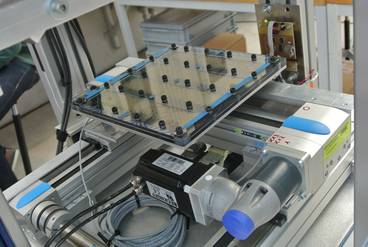stripe formation in vibrated granular submonolayers (Fall of Fame)

research area: materials science
experiment title:
Stripe Formation in Vibrated Granular Submonolayers
experiment acronym: DYT
funding agency:
ESA (Education) / ZARM
grant number:
Drop Your Thesis! - Program
performing organization:
Institute for Multiscale Simulation, Friedrich-Alexander Universität Erlangen-Nürnberg, Germany
prime investigator:
Prof. Dr. Thorsten Pöschel
(Benjamin Mockenhaupt, Tobias Netter, Phillip Neuner, Raphaela Prach)
experiment objective
abstract
In many situations, granular systems subjected to external agitation have a tendency to segregate, rather than to mix. This phenomenon is of enormous importance in industrial applications. When mixtures of particles differing in size, shape or material properties are agitated, a variety of pattern formation phenomena are observed (e.g. I. Aranson & L. Tsimring, “Granular Patterns”, Oxford University Press, 2009). The effect we plan to study in this project belongs to the class of stratification phenomena, that is, as the result of a dynamical process, the particles arrange themselves in form of stripes. Stratification in granular systems is a rather general process and can be found in various systems. Frequently, stratification patterns can be found in geological systems. Albeit a variety of mechanisms have been proposed (A. Washburn, “Classification of Patterned Ground and Review of Suggested Origins”, Geol. Soc. Am. Bull.,1956), their spontaneous formation is still unclear.
Stratification of particles is observed when a binary mixture of particles of different sizes, densities or surface properties in a shallow container is subjected to horizontal vibrations. Here the particles organize themselves in stripes oriented perpendicular to the direction of shaking. Dependent on the parameters of driving, the filling height and the particle characteristics, transitions between unordered phases and organized patterns can be observed. The process of stripe formation in horizontally vibrated shallow bidisperse systems can be phenomenologically described by a monodisperse system of particles interacting via an effective attractive short-range anisotropic interaction (Ciamarra et al.,” Dynamically induced effective interaction in periodically driven granular mixtures”, PRL, 2006).
While a large body of literature exists regarding coarsening and segregation in vertically vibrated (sub-) monolayers and shallow systems, surprisingly little is known about coarsening and phase segregation in granular systems when subjected to horizontal vibrations. According to our knowledge, horizontally vibrated sub-monolayers were only addressed by Rehberg and co-workers (A. Betat et al., “Formation of patterns in granular materials” in F. H. Busse and S. C. Müller “Evolution of spontaneous structures in dissipative continuous systems”, Springer, 1998, T. Schnautz et al. “A horizontal Brazil-Nut effect and its reverse”, PRL, 2005). Related phenomena of phase separation and segregation are observed for swirling excitation (e.g. circular vibration) of a horizontal sub-monolayer of granular material as well as in horizontal containers when one of the side walls vibrates. Besides being of interest by their own, fluidized granular media in shallow agitated containers have been studied extensively since these quasi-two dimensional systems can be easily analyzed regarding the collective behavior and the motion of individual grains. Understanding the physics of these systems on the microscopic scale and on the collective scale could lead to a more general theoretical understanding of the collective dynamics of granular media.
The aim of the present project is to explain pattern formation in horizontally vibrated sub-monolayers of identical, almost spherical particles as a consequence of frustration effects due to friction of the particles.
A previous experiment investigated the structure formation of a sub-monolayer of about 4800 approximately spherical mustard seeds of radius r = (0.11 ± 0.01) cm. The particles were confined in an unpolished aluminum box of length 50 cm and width 10 cm. The box was mounted longitudinal on a linear bearing and driven by a motor to subject it to horizontal vibrations. The response of the system to sinusoidal osciallation at different amplitude and frequencies was studied. (D. Krengel, “Phänomen der Streifenbildung bei Schwerkraft”, diploma thesis, Uni Erlangen, 2012). In this experiment a digital camera was used to observe the system from above using phase-locked imaging. As in a similar experiment, performed by Rehberg et al., rapid formation of a stripe pattern oriented perpendicular to the direction of driving was observed.
related publications
- Stripe Formation in Vibrated Granular Submonolayers (Fall of Fame), Drop Your Thesis! 2013 - Final Report. ESA Human Spaceflight and Exploration, Erasmus Experiment Archive
experiment campaigns
experiment year: 2013
number of catapult launches: 5


 "
"